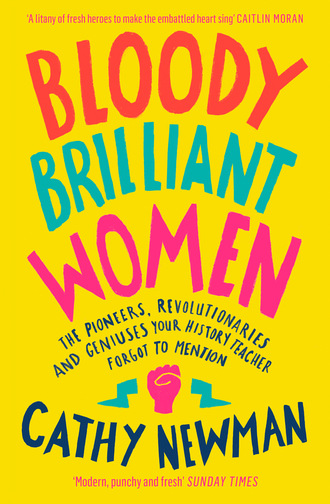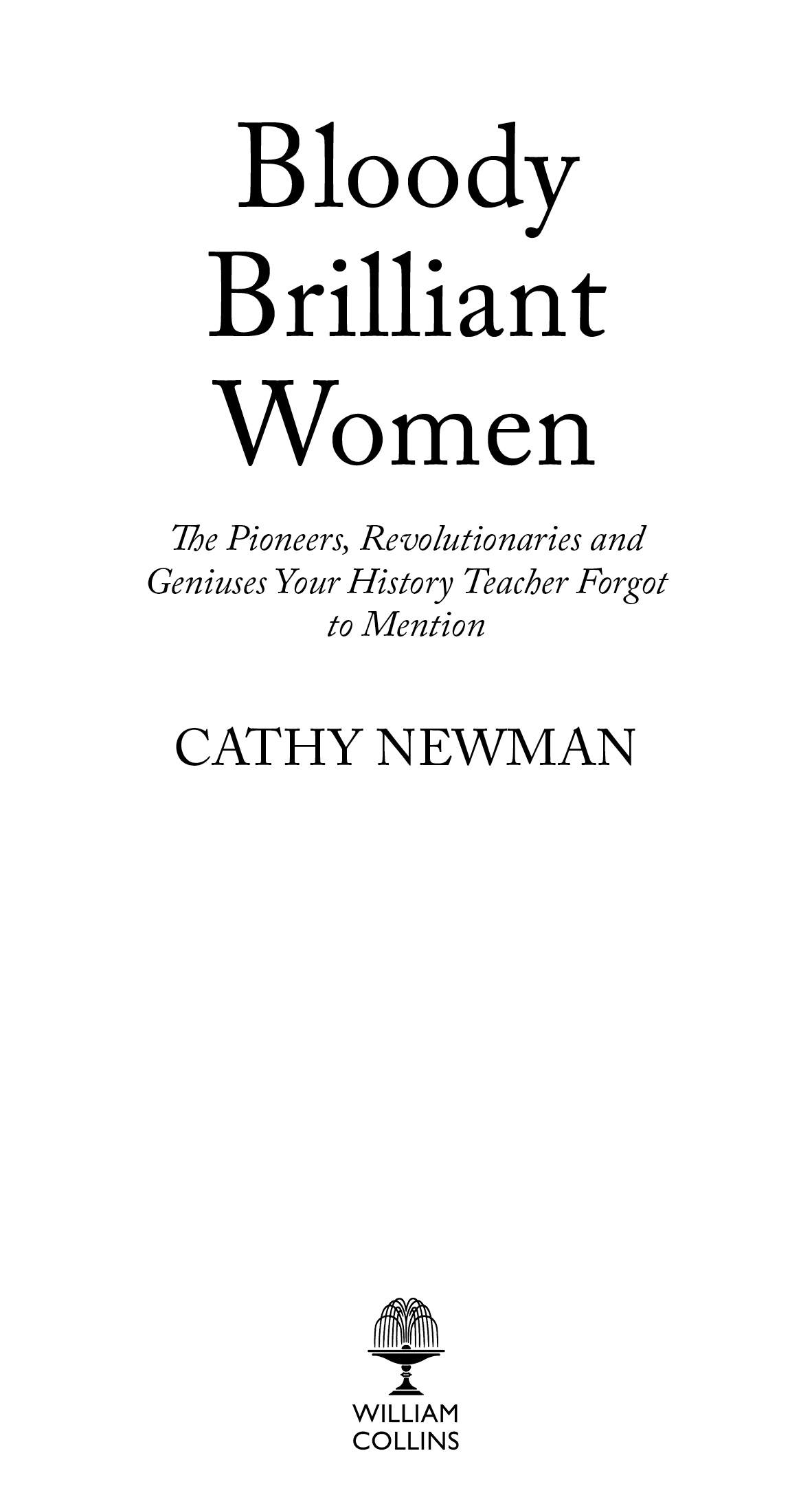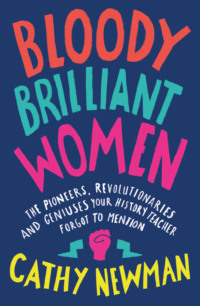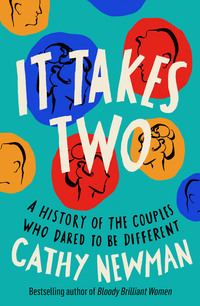
Полная версия
Bloody Brilliant Women


Copyright
William Collins
An imprint of HarperCollinsPublishers
1 London Bridge Street
London SE1 9GF
WilliamCollinsBooks.com
This eBook first published in Great Britain by William Collins in 2018
Copyright © Cathy Newman 2018
Cover design by Anna Morrison
Cathy Newman asserts the moral right to be identified as the author of this work
A catalogue record for this book is available from the British Library
All rights reserved under International and Pan-American Copyright Conventions. By payment of the required fees, you have been granted the non-exclusive, non-transferable right to access and read the text of this e-book on screen. No part of this text may be reproduced, transmitted, down-loaded, decompiled, reverse engineered, or stored in or introduced into any information storage and retrieval system, in any form or by any means, whether electronic or mechanical, now known or hereinafter invented, without the express written permission of HarperCollins.
Source ISBN: 9780008241674
Ebook Edition © October 2018 ISBN: 9780008241698
Version: 2020-09-01
Dedication
To John and our two bloody brilliant little women
Contents
Cover
Title Page
Copyright
Dedication
1 Introduction: Education, Education, Education
2 Old Battles, New Women: 1880–1914
3 Of Soldiers and Suffrage: 1914–18
4 Between the Wars: 1918–39
5 Daughters of Britain: 1939–45
6 Remake, Remodel: 1945–61
7 It’s a Man’s World: 1961–81
8 What You Really, Really Want: 1981–2017
Acknowledgements
Selected Bibliography
Notes
Picture Section
Index
About the Author
About the Publisher
1
Introduction
Education, Education, Education
This is definitely one to file under You Wouldn’t Get Away with It Nowadays, but when I was at school studying for my History A Level, our teacher used to take select groups of pupils to visit the bomb shelter from the Second World War at the bottom of his garden. I think he’d just watched Dead Poets Society, which had recently come out, and decided to portray himself as an inspirational eccentric.
I was never invited; but I like to imagine the group sitting on the damp earth beneath the corrugated tin roof as Mr Dead Poet read to them in faltering torchlight, breaking off every so often to quote Churchill. Perhaps even my favourite Churchillism: ‘My education was interrupted only by my schooling.’
That’s how I feel about school too. The vagaries of the curriculum in the late 1980s meant I studied the Anglo-Saxons about three times. For years I knew all about the Venerable Bede but almost nothing about anything that happened after 1066.
To this day, I remain embarrassed by the holes in my knowledge. Throughout my adult life I’ve bought – though admittedly not read – every history book I can lay my hands on. ‘History of Britain’-type books promising a broad overview are my particular pleasure.
Recently, when I was fifty or so pages into one of these great tomes, I had a bit of a eureka moment. I noticed that, apart from Mrs Thatcher and Queen Elizabeth II, who are in a category of their own, not a single woman had so far been mentioned.* I read on, increasingly incredulous, until finally one appeared: Agatha Christie, in the context of something about her influence on the ‘national imagination’.
Perhaps I’m being unfair. A book like the one I was reading, whose opening chapters dealt with war and its management by male politicians, was always going to be light on women. Still, many accounts of modern British history are patchy when it comes to gender, celebrating the achievements of, say, the suffragettes in a burst of fluorescent righteousness, only to pack women away again in a cupboard marked ‘Lowly, Ancillary Roles; Housewives, etc.’ until the 1960s. At which point they are allowed out to be totems of the sexual revolution, burn their bras and go on strike at Dagenham’s Ford plant.
The truth had to be more nuanced. And the deeper I delved into the history of twentieth-century Britain, the more it appeared that the shape and extent of female influence was far greater than generally acknowledged. I’m not just talking about the arts or education, where talented women have long been celebrated, but in traditionally ‘male’ fields like medicine, politics, law, engineering and the military. Were it not for women, those significant features of modern Britain such as council housing, hospices and the humane laws relating to property ownership, child custody and divorce might not exist in the same form.
The more I read about these women pioneers, the more frustrated I became that so many are so little known outside academic literature. Not only did these women achieve remarkable things, but they usually had to battle hostility and discrimination as they did so. This book is my attempt to bring these women and their accomplishments to a wider audience; to tell their story – and ours.
One of its working titles was The Class of 1918, because that is how I thought of these women while I was writing: 1918 being, if not exactly a feminist Year Zero, then the year when the ball started rolling in the direction of equality. It was the year when the Representation of the People Act allowed women to vote if they were over the age of 30 and met a ‘property qualification’. At the same time, the Parliament (Qualification of Women) Act in 1918 gave women over twenty-one the right to stand for election as MPs. Which was momentous, although it did mean that between 1918 and 1928 some women were in the odd position of being able to stand for Parliament but unable to vote: Jennie Lee was twenty-three when she stood as the North Lanark Labour candidate in the 1929 by-election, just before the rules were changed.
The Class of 1918 are those women who either prepared the ground for or immediately benefited from the burst of empowerment which followed getting the vote. For Western women, 1918 is the start of the modern era. Just as historians use the term ‘the long twelfth century’ as shorthand for the period between 1050 and 1250 – a way of rationalising the massive changes that occurred in those two hundred years – so you can argue that, for women, the twentieth century started later than it did for everyone else and hasn’t yet ended. Not until 1928 was the voting franchise in Great Britain and Northern Ireland extended to all women over the age of twenty-one, finally giving them the vote on the same terms as men.
To make sense of the modern era, you need to understand the years which immediately preceded it. So my history includes women who predate even first-wave feminism – the activist Ada Nield Chew, for example, and Octavia Hill, whose National Trust for Places of Historic Interest or Natural Beauty arose out of her campaigning for better quality housing for the poor.
-------------------------------------
That women have the same rights and opportunities as men is practically a given for my two young daughters. They watch Channel 4 News, see me interviewing what must seem like an endless procession of female politicians, bankers, lobbyists, CEOs, etc. The fact that a little over a hundred years ago most British women couldn’t even vote is scarcely credible to them. They have only the vaguest notion of what today’s modern, successful women have inherited from their forebears; of what they need to be thankful for; of how painfully slow the process of being taken seriously has been and, indeed, continues to be.
This is where the idea of ‘women’s history’ comes in. Do we still need such a thing? We certainly did – the first 1885 edition of the prestigious Dictionary of National Biography found room for only 3 per cent of women in its sixty-two volumes – and I would argue we still do.
Of course, the danger of gathering together the experiences of so many different women (black, white and Asian; straight or LGBTQ+) is that the specificity of those experiences to those particular women gets overlooked. They may have trodden similar paths and faced similar pitfalls. But oppression comes in many shapes and sizes.
Even primary-school children now learn that the kind of discrimination Florence Nightingale had to overcome as a wealthy, upper-middle-class, well-connected English woman was very different to that experienced by her fellow nurse Mary Seacole as a mixed-race woman (a ‘mulatto’, in the language of the day) who identified as both Scottish and Jamaican. I have done my best in what follows to bear this in mind.
This is not a textbook. I have tried to write about these remarkable women in an accessible and entertaining way. At its heart, though, are two basic questions: what were the sources of female power in the twentieth century? And what have women used this power to achieve?
The answers are complex because female power is complex. Even if we accept that, for much of human history, women have conducted their lives in a patriarchal bubble – subordinate in law, custom and religion to the men around them; not even wanting equality with men, so ridiculous did the idea seem – it doesn’t mean they lacked purpose and agency. And it doesn’t mean we shouldn’t celebrate their achievements.
As modern women, we are instinctively drawn to a certain species of trailblazer – the women it’s easy and satisfying to claim as proto-feminists. But not all of them would be pleased to wear the T-shirt.
Take the eighteenth-century writer and philanthropist Hannah More for starters. It was fine, she thought, to teach poor women to read so that they could understand the Bible; but she was shocked by women she had heard about in France who ‘run to study philosophy, and neglect their families to be present at lectures in anatomy’, and she loathed the sort of education reforms proposed by Mary Wollstonecraft: ‘How many ways there are of being ridiculous!’
When the explorer Mary Kingsley returned from the second of her expeditions to West Africa in October 1895, she distanced herself from the New Women then being discussed in newspapers, arguing that women’s suffrage was ‘a minor question; while there was a most vital section of men disenfranchised women could wait.’ The polymathic explorer Gertrude Bell – one of the cleverest, most remarkable British women of the early twentieth century – couldn’t understand why women wanted the vote. Believing the whole business to be a silly distraction from the grand imperial project to which she was committed, she became first secretary of the Women’s National Anti-Suffrage League.
Another modern feminist reflex – and I must plead guilty here – is to scoff at traditional ‘homemaker’ roles. It’s one thing to believe, as I do, that too many women remained trapped in them for too long, their intellectual freedom of movement curbed; but it’s quite another to claim that they have no value. The opposite is the case: it was domestic power that many of the women featured in this book harnessed.
High-born historical heroines wouldn’t have been doing the dishes, yet frequently their lot was to be also-rans: nearly-queens such as Matilda, daughter of Henry I, who just missed out on the throne in 1153; or queens who stood in for absent monarchs such as Eleanor of Aquitaine, who governed England while her son Richard the Lionheart was off fighting the crusades. In her brilliant book about these pre-Tudor queens, She-Wolves (2010), the historian Helen Castor notes that their power was perceived as ‘a perversion of “good” womanhood, a distillation of all that was most to be feared in the unstable depths of female nature’.1 It was a view promoted most famously by the Scottish reformer John Knox in his polemic of 1558, The First Blast of the Trumpet Against the Monstrous Regiment of Women: ‘For nature hath in all beasts printed a certain mark of domination in the male and a certain subjection in the female which they keep inviolate.’
Gems like this kept me entertained as I was writing. But how, I wondered in my ignorance, did Knox feel justified in writing this stuff in the sixteenth century when in many ways women had been bossing it for hundreds of years before that?
‘The history of England,’ wrote the historian and politician Macaulay, ‘is emphatically the history of progress.’ Not for women, it isn’t. In key respects, they were better off in 800 than they were in 1800. I didn’t notice this sufficiently when I was eighteen and studying history. (I barely noticed anything when I was eighteen. I was too busy bemoaning my curly hair and bottle-top glasses.) Now, in my forties, I found myself wondering what had gone wrong since Anglo-Saxon times, when women were accorded considerable respect.
Surviving evidence, some of which I’ll outline below, led the historian Doris Stenton to conclude that Anglo-Saxon women were ‘more nearly the equals of their husbands and brothers than at any other period before the modern age’.2 At this point the fake-news klaxon sounds in the back of my head. Some historians3 dispute Stenton’s ‘Golden Age’ thesis, so I should note that we have little concrete information about how women actually lived. Anglo-Saxon culture was mostly oral, so what we know comes from clerical and legal records and, least reliably of all, heroic poems.
Still, language tells its own story, and it’s significant that the Old English word mann can also be used of women. A charter from 969 that relates to a grant of land near Worcester concludes: ‘Aelfweard was the first man, and now it is in the hands of his daughter and she is the second man.’ As we in the twenty-first century tussle over gender-neutral toilets, our Anglo-Saxon ancestors might have wondered what on earth all the fuss was about.
Anglo-Saxon marriage, too, sounds almost progressive, especially compared to the bond of misery endured by many Victorian women. A husband had to pay his prospective wife a morgengifu or ‘morning-gift’, often a considerable amount of money or land, over which she had total control. Finances were the joint responsibility of husband and wife. According to the laws of Aethelbert, a woman could walk out on a marriage if she was unhappy, and if she took her children with her then she was entitled to half the marital home. How very equitable.
‘Cunning women’ had considerable power in Anglo-Saxon communities, practising folk magic, using their powers to heal, hex and hunt down stolen goods. Pendants, crystal balls, shells and other amulets thought to have magical properties have been found in the graves of female Anglo-Saxons. And although we might bridle when we read, in the tenth-century anthology of Anglo-Saxon poems and other literature known as the Exeter Book, that ‘the place of a woman is at her embroidery’, cloth-making and embroidery were in fact high-prestige occupations. In the households of large-estate owners, many of whom were women, the mistress of the house and her daughters would have worked making adorned gifts or, after the arrival of Christianity, church vestments. More mundane soft furnishings such as wall-hangings, table linen and bed clothes were handed down as heirlooms, and more commonly mentioned in the wills of women than men, suggesting they were thought of as female property.
The needle was by no means the only tool in women’s armoury. Female warriors wielded more traditionally masculine weapons to great effect. We know that a strong tradition of female warriors existed in pre-Anglo-Saxon Britain from Tacitus’ account of the Iceni queen Boudica’s rebellion against the Romans. He puts into her mouth a rousing speech in which she assures her troops that it is ‘customary … with Britons to fight under female captaincy’. Boudica rides in a chariot with her daughters in front of her and fights not as a queen but as a ‘woman of the people’ to avenge ‘her liberty lost, her body tortured by the lash, the tarnished honour of her daughters’.
High-born Anglo-Saxon women, too, could be every bit as blood-thirsty as the men. Queen Cynethryth, wife of Offa of Mercia, is a Lady Macbeth figure who not only had coins struck in her name, but is supposed to have encouraged Offa to kill Aethelberht II of East Anglia. Aethelflaed, daughter of King Alfred (of cakes infamy) assumed power after her husband Aethelred, Lord of the Mercians, died in 911. A formidable warrior who ‘protected her own men and terrified aliens’ (according to William of Malmesbury), she ruled for the next seven years, implementing an ambitious programme of fortification and fending off attacks from marauding Vikings and Danes.
The arrival of Christianity in the British Isles is usually dated to 597, the year Augustine became the first Archbishop of Canterbury and baptised the first Christian Anglo-Saxon king, Aethelberht of Kent. Many of the monasteries that subsequently dotted the landscape were ‘double monasteries’ where an abbess ruled over both monks and nuns, who lived in separate buildings.
Thanks to good old Eve, notions of female inferiority are hardwired into Christianity. Nevertheless, women emerge in this period as effective religious leaders, not least because of their apparent gifts for diplomacy and realpolitik. Medieval historian Henrietta Leyser thinks women adapted to Christianity more easily than men because they were better at reconciling new demands with old codes: ‘[Women] take up its challenges with alacrity and with evident success. They become saints apace, exercising power in life and in death: in life in positions of influence as abbesses, in death through miracles worked at their shrines.’4
Most of what we know about these abbesses comes to us via my old friend from the history class, the Northumbrian monk Bede, aka ‘the godfather of history’. His favourite seems to have been Hilda of Whitby, who founded Whitby Abbey and was famously wise: according to Bede, ‘not only ordinary people but also kings and princes sometimes sought and received her counsel when in difficulties.’ One of her most celebrated feats was her discovery and encouragement of the cowherd-poet Caedmon, composer of one of the earliest known vernacular poems, ‘Caedmon’s Hymn’.
These ‘brides of Christ’ could be flamboyant, glamorous figures, their celebrity an important source of local pride. St Edith, abbess of Wilton Abbey in Wiltshire, was famous for dressing in ornate, golden clothes (albeit with a hair shirt worn underneath). William of Malmesbury tells how, when she was ticked off for this by Aethelwold of Winchester, she retorted that this opulence didn’t matter because God could see through superficial trappings to the soul beneath: ‘For pride may exist under the garb of wretchedness; and a mind may be as pure under these vestments as under your tattered furs.’
After 1066, many (though not all) historians agree, a lot of that girl power withered on the vine, in the church and beyond. Freedoms taken for granted in Anglo-Saxon society were undermined by new canon (religious) law and the Normans’ insistence on making land ownership a condition of military service to a lord. From 1066, the number of female land-owners drops. Women can no longer make wills. Husbands are permitted to beat their wives. Primogeniture transforms inheritance law so that first-born sons are valued over daughters. If a woman kills her husband, it’s classed as treason and punished accordingly by burning at the stake.
The idea that women are second-class citizens, physically and mentally inferior to men, becomes a commonplace as medieval Catholic theology sets up new and troubling archetypes that remain with us – on the one hand, Eve; on the other, the Virgin Mary.
Consider the Bayeux Tapestry, the 230-foot long piece of embroidered cloth thought to have been commissioned by William the Conqueror’s brother. As all schoolchildren know, it tells the story of the Norman conquest, culminating in the Battle of Hastings. Although it was made by English women – women whose needlework skills were so famous throughout Europe that their work had a special name, Opus Anglicanum (‘English work’) – it depicts only three women: Queen Edith of Wessex, wife of Edward the Confessor and sister of the slain Harold; a mysterious figure called Aelfgyva, whose presence seems to be a reference to some unknowable contemporary sex scandal; and finally, an anonymous war refugee fleeing with her child from a burning building. Notice the way these women fall neatly into three categories: inheritors of and revellers in wealth and status; sources of gossip and intrigue; and helpless victims. Is the Bayeux Tapestry a precursor of the Daily Mail Online’s notorious ‘sidebar of shame’?
Still, our medieval sisters struggled on. They oversaw births and deaths as midwives and layers-out of bodies. Some ran businesses from their houses. If they were married they could and often did declare themselves unmarried in order to escape the common-law disadvantages of being wives. (Their husbands were happy to be complicit in this as it absolved them of liability for any debts.) This was known as trading feme sole and gave women a bit of economic independence, especially in areas like the silk trade; in trades less female-dominated they probably fared worse.
Alice Chester carried on her husband’s business after his death in 1473. She used her own ships to trade in cloth, wine and other commodities with Ireland, Spain, Portugal and Flanders and made enough money to afford a town house in Bristol and to lavish expensive gifts on her local church, which included elaborate carved figures and a new rood loft. Margaret Paston ran her lawyer husband John’s malt and wool business when he was away, as well as defending the family estates in Norfolk from armed bandits. When they were separated, Margaret kept in contact with John by letter, many of which have survived to provide us with arresting insights into life in England during the War of the Roses. In 1449 she wrote to John demanding crossbows, grappling irons and shooting bolts for use in defending the Paston castle at Gresham against an attack by Lord Molynes. Margaret and her twelve comrades-in-arms never stood a chance against Molynes’ thousand-strong army, and she was duly evicted and the castle sacked. But she didn’t lack courage or resourcefulness.
We learn a fair bit about the lifestyle of a bourgeois woman in a thriving provincial town from Margery Kempe, the Christian mystic whose dictated autobiography, dating from the 1420s and surviving in a single manuscript discovered in the 1930s, is one of the earliest known memoirs by a woman. Much of it relates to her spiritual journey, undertaken in the grip of what sounds like post-partum psychosis.
Among the religious revelations is the more fascinating one that Kempe ran a microbrewery in her home town of Norwich. The Book of Margery Kempe is pleasingly graphic about what ensued on the day a batch of ale became contaminated: ‘When the ale had as fine a froth on it as anyone might see, suddenly the froth would go flat, and all the ale was lost in one brewing after another, so that her servants were ashamed and would not stay with her.’5 Having only taken up brewing in the first place ‘out of pure covetousness’, Kempe interpreted this stalled fermentation as a punishment from God.



